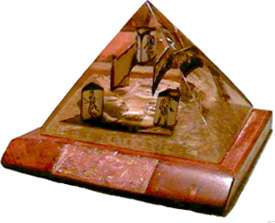The Adventures of Indiana Jones Role-Playing Game
|
The Adventures of Indiana Jones Role-Playing Game | |
| Designer(s) | David Cook |
|---|---|
| Publisher(s) | TSR, Inc. |
| Publication date | 1984 |
| Genre(s) | Period adventure/alternate history |
| System(s) | Custom |
The Adventures of Indiana Jones Role-Playing Game is a role-playing game based on the Indiana Jones franchise. The game was designed and published by TSR, Inc. under license in 1984.[1] Ten years later, West End Games acquired the rights to publish their own Indiana Jones role-playing game, The World of Indiana Jones.
History
Publication stopped when the licensing rights to the Indiana Jones property expired. All unsold copies of the game were destroyed at that time. Employees at the UK office of TSR Hobbies mounted a portion of the burnt remains of the last copy in a small pyramid trophy made of Perspex. Beginning in 2000, the trophy became known as the "Diana Jones Award for Excellence in Gaming".
A set of pewter miniatures were also marketed in 1984 for use with the game, which the player could choose to use instead of the cardboard cutouts that were provided with each book.
Setting
The setting of the game is historical, 1930's pulp era. Players can choose to set aspects of the game at any point in the mid-to-late 1930s. Some adventure packs establish a particular timeline, while others are left to the player's discretion.
System
Designed for 2 to 8 players, the game is run and scenes are laid out by a game master, called a referee. Each adventure pack specifies which of pre-made characters are available to be played, and provide a character dossier which displays their attributes, abilities, and a health chart. Provided maps, tables, and cut-out game pieces represent the setting and characters, and are used to determine character positioning, range, line of sight, and movement.
Characters
The players choose one of seven pre-made characters based on those from the movies: Indiana Jones, Marion Ravenwood, Short Round, Willie Scott, Sallah (the digger), Jock Lindsay (the pilot), or Wu Han (an old friend of Indy's).
Each character has seven attributes to decide basic factors in the game: Strength (physical strength), Movement (action speed), Prowess (manual dexterity, coordination), Backbone (courage, determination), Instinct (perception, intuition), and Appeal (personality, physical attractiveness). When a particular feat is attempted, a check is made against the character's appropriate attribute by rolling a d100. Modifiers to the roll or attribute may be applied by the referee, based on game circumstances. If one rolls lower than their modified attribute score, the action is successful. If it is higher, the action fails. Outcome is determined by the referee.
The character generation rules for the TSR game was introduced in the accessory pack IJAC1, Judge's Survival Guide, a year after the game was introduced.
Combat
Combat is done in turns, each of which equals five seconds of in-game time. Players with the highest movement attribute have the chance to act first with a check against that attribute. Whether one is able to land a blow depends on a check against their prowess attribute, and the amount of damage done is determined by a "Modified Check Table" provided in the game rules. There are three levels of damage: light, medium, and serious. The reversed number rolled for the prowess check, looked up on the provided "Action Results Table" determines where the blow landed, if not otherwise decided by the referee. Other forms of combat, such as shooting are done in the same way, only the provided maps must be used to determine range and line of sight. No formal system of hit points or determining actual character death is put forth, and instead is left to the referee as a role-play element.
Themes
Most of the themes of the game are centered on the movies and comics, with Indiana Jones and his companions procuring items of archeological importance, while battling Nazis, rival archeologists, violent natives, gangsters, and anything else the referee chooses to put forth in the storyline. Even in the prepared adventure packs, sequence results are largely left open to player determination based on referee guidance.
Many of the modules published had no specific year in which the adventure took place; however, the setting of Temple of Doom was in 1935, and the setting of Raiders of the Lost Ark was in 1936. Material from the comic series, Further Adventures of Indiana Jones was used for plots in some of the TSR publications.
Products
Adventure packs
- IJ1 - Indiana Jones and the Temple of Doom Adventure Pack. Tracy Hickman & Michael Dobson (TSR, 1984)
- IJ2 - Raiders of the Lost Ark Adventure Pack. Douglas Niles (TSR, 1984)
- IJ3 - Indiana Jones, Crystal Death. Tracy Hickman (TSR, 1984)
- IJ4 - Indiana Jones, the Golden Goddess. Ed Carmien (TSR, 1985)
- IJ5 - Indiana Jones, Nepal Nightmare Adventure Pack. Marlene Weigel (TSR, 1985)
- IJ6 - Indiana Jones, Fourth Nail Adventure Pack. Tracy Hickman (TSR, 1985)
Accessory packs
- IJAC1 - Indiana Jones, Judge's Survival Johnson, Harold. (TSR, 1985)
References
- ↑ "The History of TSR". Wizards of the Coast. Archived from the original on 2008-10-04. Retrieved 2005-08-20.

